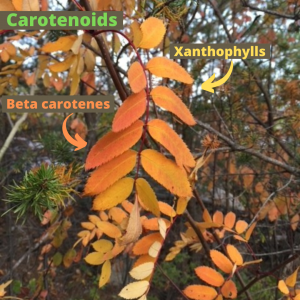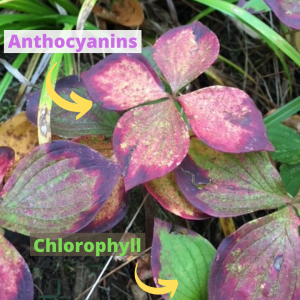Considering Fall Colors
It’s the season of change here in our pocket of the world. The nights are getting cooler. The bugs are no longer buzzing around our heads. The sun sets as the last crumbs are eaten off of our dinner plates. Most noticeably, the leaves are in the midst of their annual color transformation. But I suppose calling it the “season of change” is redundant, isn’t it? Season denotes change. Without change, there would be no need for the word “season”.
After working at Wilderness Canoe Base many different seasons over the past six years, I am elated to finally be here in autumn for the first time. Despite already high expectations of the beauty this time and place would present to me, I have been overwhelmed by the intensity and variation of color in this boreal landscape. I thought I had great familiarity with blueberry and bunchberry plants, mountain maples and aspens. Yet, before two weeks ago, I could not have described to you the deep red of blueberry leaves in fall or the way the edges of mountain maple leaves often turn a neon pink before fully departing from their verdant quality.
In complete awe of this colorful landscape like no other I’ve seen before, I set out to learn how and why such an impeccable palette exists in this locale. With the help of information from the U.S Forest Service and americanforests.org, I was able to gain an even greater appreciation for the “reason behind the season”.
A leaf’s primary purpose is to capture sunlight, water, and carbon dioxide from the air and absorb those into the tree. Chlorophyll, which is what gives leaves their green color, uses sunlight to break down the carbon dioxide (CO2) and water (H2O) into oxygen (O2) and glucose (C6H12O6) through the process we call photosynthesis. The oxygen is expelled into the air (humans gratefully receive that gift!) and the glucose becomes energy for the tree. As days become shorter and temperatures decline in the autumnal months, the tree has fewer resources to consume. Rather than waste precious energy on maintaining leaves, the tree produces a cell layer, called an abscission layer, that gradually blocks the flow of nutrients to and from the leaves. As this layer is formed, the chlorophyll in each leaf, which normally is broken down when exposed to sunlight, can no longer be replaced. This is when new colors come into sight.
 Carotenoids, chemicals that produce orange (beta carotene) and yellow (xanthophylls) colors exist in leaves all spring and summer, but are masked by the green of chlorophyll. However, as the chlorophyll breaks down, the carotenoids become the more prominent chemicals, causing leaves to turn some variation of yellow and/or orange. In contrast, chemicals called anthocyanins, which create red and purple colors, are actually produced only in the autumn from glucose that has been trapped by the abscission layer. Any leaf you see in the fall that has transformed from its original green, is experiencing a unique combination of all these chemicals interacting to create the exact coloration you see. Temperature, moisture, sunlight, and tree type all play a role in producing the yellows, oranges, pinks and reds of autumn. Finally, as sunlight breaks down the carotenoids and anthocyanins over time, tannins found in the cell membranes remain in the leaves, leaving the brown color as they begin to decompose back into the soil which will soon play host to new life.
Carotenoids, chemicals that produce orange (beta carotene) and yellow (xanthophylls) colors exist in leaves all spring and summer, but are masked by the green of chlorophyll. However, as the chlorophyll breaks down, the carotenoids become the more prominent chemicals, causing leaves to turn some variation of yellow and/or orange. In contrast, chemicals called anthocyanins, which create red and purple colors, are actually produced only in the autumn from glucose that has been trapped by the abscission layer. Any leaf you see in the fall that has transformed from its original green, is experiencing a unique combination of all these chemicals interacting to create the exact coloration you see. Temperature, moisture, sunlight, and tree type all play a role in producing the yellows, oranges, pinks and reds of autumn. Finally, as sunlight breaks down the carotenoids and anthocyanins over time, tannins found in the cell membranes remain in the leaves, leaving the brown color as they begin to decompose back into the soil which will soon play host to new life.
 The magnificent colors of autumn leaves seem simply to be (though probably are not entirely) a byproduct of trees adapting to change. After considering how much I admire the visual produced by that adaptation, I wonder if the trees can be our teachers at this moment. One can hardly argue that things are changing these days, at a rapid and often alarming pace. Yes, change has always existed, but it hit us in a new way with the current Covid-19 pandemic. We have had to make so many adaptations in nearly every aspect of life: wearing masks in public, connecting with friends via zoom, ordering food to take home or to a park, and teaching or attending classes completely remotely. As the pandemic has gone on, it has become clear to me that many things will never go back to “the way they were”. That can be terrifying to think about. But if we look again at those vibrant fall leaves, proof of resilience and the preparation for a new season, it is easier to have faith that we, too, can adapt to our changing world and continue to create stunning beauty through actions of kindness, empathy, and inclusivity.
The magnificent colors of autumn leaves seem simply to be (though probably are not entirely) a byproduct of trees adapting to change. After considering how much I admire the visual produced by that adaptation, I wonder if the trees can be our teachers at this moment. One can hardly argue that things are changing these days, at a rapid and often alarming pace. Yes, change has always existed, but it hit us in a new way with the current Covid-19 pandemic. We have had to make so many adaptations in nearly every aspect of life: wearing masks in public, connecting with friends via zoom, ordering food to take home or to a park, and teaching or attending classes completely remotely. As the pandemic has gone on, it has become clear to me that many things will never go back to “the way they were”. That can be terrifying to think about. But if we look again at those vibrant fall leaves, proof of resilience and the preparation for a new season, it is easier to have faith that we, too, can adapt to our changing world and continue to create stunning beauty through actions of kindness, empathy, and inclusivity.
Written by Solveig Orngard, Fall Staff 2020